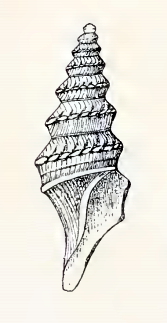Biology:Paracomitas augusta
| Paracomitas augusta | |
|---|---|

| |
| Original image of a shell of Paracomitas augusta | |
| Scientific classification | |
| Domain: | Eukaryota |
| Kingdom: | Animalia |
| Phylum: | Mollusca |
| Class: | Gastropoda |
| Subclass: | Caenogastropoda |
| Order: | Neogastropoda |
| Superfamily: | Conoidea |
| Family: | Pseudomelatomidae |
| Genus: | Paracomitas |
| Species: | P. augusta
|
| Binomial name | |
| Paracomitas augusta (Murdock & Suter, 1906)
| |
| Synonyms[1] | |
| |
Paracomitas augusta is a species of sea snail, a marine gastropod mollusk in the family Pseudomelatomidae, the turrids and allies.[1]
Description
The length of the shell attains 10.3 mm, its diameter 3.9 mm.
(Original description) The fusiform shell is slender and fragile The spire and the body whorl are of about the same length. The whorls with a spiral keel bear small nodules The siphonal canal is long.
Sculpture : The whorls are strongly keeled at the periphery and with a row of gemmules set slightly oblique thereon. On the body whorl there is a lower smooth keel present. A few inconspicuous spiral striae are on the area between the keels and on the anterior extremity. The axial sculpture consists of minute and irregular growth lines only. The colour is pure-white, slightly shining. The spire is pagodiform and elongated. The protoconch is smooth and shining, consisting of about two turns. The nucleus is slightly tilted, and with a distinctly marked smooth carina, which is much strengthened on the succeeding whorl. The shell contains 7 whorls, regularly and rather slowly increasing, the last biangulate, concave below the keels and produced into a rather long narrow and truncated beak. The suture is deep, minutely bimarginate. The aperture is angularly ovate, broadly angled above, contracted below and terminating in a rather long open siphonal canal, which is somewhat turned to the left. The outer lip has its margin not quite perfect, which perhaps lends to the scarcely fully adult appearance of the shell. It is biangled and concave above, between, and below the angles ; sinus broad and moderately deep, extending almost from the suture to the keel. The inner lip spreads as a very thin narrow callus over the concave body and the columella, which is nearly straight and slightly twisted, ending in a fine point on the left margin of the siphonal canal.
Distribution
This marine species is endemic to New Zealand.
References
- ↑ 1.0 1.1 Paracomitas augusta (Murdock & Suter, 1906). Retrieved through: World Register of Marine Species on 31 March 2010.
- Murdoch, R. & Suter, H. (1906) Results of dredging on the continental shelf of New Zealand. Transactions and Proceedings of the New Zealand Institute, 38, 278–308, pls. 21–27
- Beu, A.G. 2011 Marine Molluscs of oxygen isotope stages of the last 2 million years in New Zealand. Part 4. Gastropoda (Ptenoglossa, Neogastropoda, Heterobranchia). Journal of the Royal Society of New Zealand 41, 1–153
External links
- Tucker, J.K. (2004). "Catalog of recent and fossil turrids (Mollusca: Gastropoda)". Zootaxa 682: 1–1295. doi:10.11646/zootaxa.682.1.1. http://www.mapress.com/zootaxa/2004f/z00682f.pdf.
- Spencer H.G., Willan R.C., Marshall B.A. & Murray T.J. (2011). Checklist of the Recent Mollusca Recorded from the New Zealand Exclusive Economic Zone
- Tepapa collections: Paracomitas augusta powelli
Wikidata ☰ Q3140656 entry
 |

